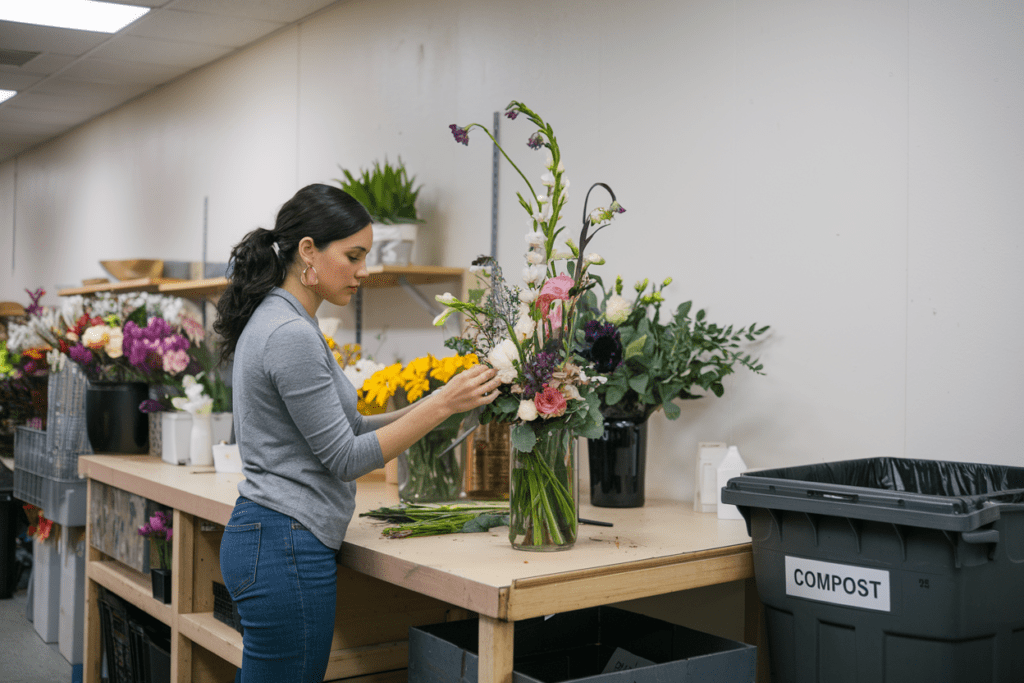
Florists are increasingly committed to sustainability, but many still face significant hurdles.
A recent survey, Perceptions of Environmentalism & the Use of Sustainable Floral Design Practices within the Floral Industry, revealed that almost half (46%) of florists surveyed see barriers like high costs (almost 46%), lack of sustainable alternatives (18%), and limited access to eco-friendly products as obstacles (16%).
The survey, facilitated by the Floral Marketing Fund, netted 453 respondents. Most worked in retail floral shops or as freelance florists as business owners or managers.
We asked industry professionals to weigh in on those barriers and others and provide suggestions about how florists can overcome them.
“It’s Too Expensive”
Joseph Langlois of Bangor Floral in Bangor, Maine buys local, recycled and eco-conscious products. “Yes, there are some products that are more expensive, but some have come down as well,” he says. Any elevated costs for more sustainable products are built into Bangor Floral’s pricing. Langlois says he advertises the shop’s sustainable options to customers, and they’re willing to pay a little more. Another industry survey released last year affirms Langlois’s observation. About 50% of consumers surveyed said they were willing to pay 10% or more if the florist uses sustainable practices, according to the survey, “U.S. Consumer Perceptions & Willingness to Pay for Sustainable Environmental Practices in the Floral Industry,” facilitated by the Floral Marketing Fund.
“There Aren’t Sustainable Alternatives”
Look to the past, says James DelPrince, Ph.D., AAF, PFCI, AIFD, associate professor at Mississippi State University Extension Service in Biloxi, Mississippi, and one of the researchers on the survey. “If you look at the history of floral design before plastics were even invented, florists were using what was on hand,” he says. Wrapping bouquets with paper or hand-tying them with raffia ribbon, for example, are pre-plastic methods.
If you can’t find a historic way to complete your design, make something new, suggests Langlois. “Don’t just keep repeating what was always done. Redesign it, recreate it, reimagine it. Design doesn’t stand still, and neither should you.”
“Sustainable Products Aren’t Accessible”
If your wholesaler doesn’t carry a sustainable alternative, you don’t need to settle for the non-sustainable standby, says Laura Walsh, AAF, director of marketing at Smithers-Oasis. “Ask your wholesaler to bring in more sustainable products,” she says. Wholesalers work hard to source products that their customers want. If they know you want more sustainable options, they’ll expand their catalog, she says.
“There’s No Way to Compost”
If your locality doesn’t provide composting services, find a club or business to partner with, suggests DelPrince. Reach out to local garden clubs or Master Gardeners and schedule a regular pickup. Or partner with a local flower farmer who can pick up your compostable waste when they drop off your regular order. “It’s beneficial to both of you,” DelPrince says.
If you can’t find a partner for composting, you can still give your castoff flowers new life. “We dry everything,” Langlois says. In addition to dried flower arrangements, dried rose petals make a great organic toss for weddings, and dried flowers and leaves make great “scatter” for tabletops.
“The City Doesn’t Offer Recycling”
Some localities don’t have recycling facilities. Those that do may not accept all the recyclable waste your shop produces. Walsh notes that many recycling centers only accept food-safe glass, so glass vases usually end up in the landfill. The same is true for other common vase materials such as ceramic and clay. Reduce your need to purchase more by offering a vase reuse program.
DelPrince suggests finding out what can’t be recycled in your area and then slowly phasing out those materials in your shop. When you’re running low on a nonrecyclable product, work with your wholesaler to find an alternative to substitute for your next order. If your locality doesn’t offer any recycling services, try to find compostable alternatives.
“I Don’t Know How”
Don’t be complacent about what you don’t know, DelPrince says. Register for workshops, watch instructional videos online, and access other online resources, such as DelPrince’s newly released “Sustainable Floral Design: Curriculum and Projects.” You can also check out the Society of American Florists’ sustainability package on the Floral Education Hub for more information about what your peers and the industry is doing to be more sustainable. “When you’re open-minded and you’re green, you’re growing,” DelPrince says. “Build sustainability knowledge gradually for yourself and for your employees and you will find over time that your shop becomes more and more sustainable.”
Laurie Herrera is a contributing writer for the Society of American Florists.
